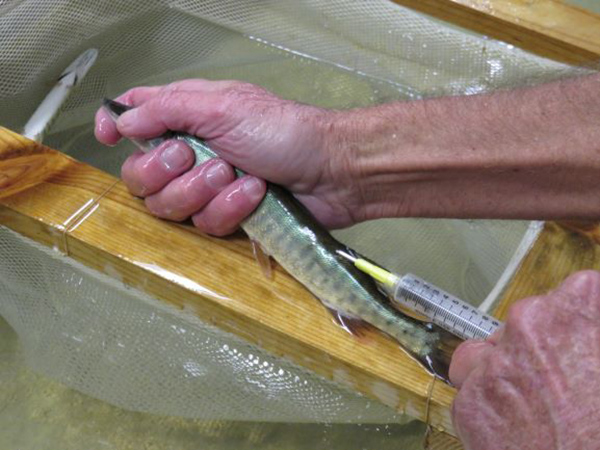By Louie Stout
 Webster Muskies on the Rebound
Webster Muskies on the Rebound
Tiny ‘PIT” tags are inserted into young muskies before they are stocked into Webster Lake. When fish managers return to take brood stock each spring, they scan each fish they net to check for tags that provide information on growth rates, survival and whether the muskies they capture are stocked fish or naturally reproduced. (Indiana DNR photo)
Jed Pearson is eager to see what he finds in nets at Webster Lake when his DNR fisheries team starts collecting adult muskies for the hatchery in the coming weeks.
The biologist hopes he’ll see more young muskies as he and anglers did last year. If he continues to find juveniles mixed in with big ones that would be a good sign that DMR fish management changes continue to produce good results.
In case you weren’t aware, 774-acre Webster Lake in Kosciusko County historically has been one of the Midwest’s best muskie fisheries.
However, the population diminished to only a few big muskies about four years ago, prompting DNR officials to revise their stocking and hatchery methods.
Webster, along with other Hoosier muskie lakes, is totally reliant on hatchery-raised fish and stocking efforts.
Pearson is optimistic that the Webster muskie fishing is on the rebound.
From 2012 through 2016, DNR crews saw only 15 young muskies when collecting adult fish for brood stock, indications that stocking efforts were failing.
In 2017, after changes were made, they encountered 50 young fish, and last spring 79 of the 126 they caught were young fish less than 34 inches long.
“When we go back in early April, we hope to see those fish and others we stocked last year,” Pearson said.
Obviously, anglers prefer bigger fish. But when you start seeing fish from several year classes that bodes well for future fishing.
Muskie anglers know that.
“The muskie guides and other fishermen tell us they caught a lot of small muskies last summer, so that’s a good sign that conditions are improving,” he said.
Over 80 percent of muskie anglers the DNR interviewed at Webster in 2005 rated fishing as ‘good.’ That number dropped to 25 percent by 2015 but rebounded again to 79 percent last year.
Pearson speculates a number of things may have contributed to Webster’s demise. It’s possible, he says, that the lake may have had too many big fish that were preying on the newly stocked fish.
Another key factor was that the lake’s vegetation was carpet bombed with weed killing chemicals by the lake association. That gave the smaller fish nowhere to hide from predators.
It was the perfect storm for a rapidly declining fishery.
So, stocking numbers and fish size were adjusted, hatchery diets for muskies were beefed up, and limitations were put on weed treatments.
All of that has helped, but Pearson believes the change in stocking numbers may be the catalyst.
Previously, only 8- to 10-inch muskies were stocked in the fall. The DNR now keeps a group of muskies well fed throughout the winter for a spring stocking when they are larger (12 inches).
The current goal is to stock 1,500 in the fall and 1,500 in the spring.
“We believe the bigger spring fish have a better chance of surviving and escaping predation,” said Pearson. “Because of the larger size, we had to stock fewer fish due to hatchery space, but when you have better survival because of the larger size, you actually get better returns.”
Oddly enough, the DNR has yet to document any muskie natural reproduction in Webster but studies have been incomplete. Now that they are placing tags in each fish stocked, they’ll not only get a handle on whether spring or fall stocked muskies are surviving best, but also if there is some natural reproduction.
Passive Integrated Transponder (PIT) tags are injected just under the skin of each muskie before it’s stocked. When the DNR collects fish in April, they will run a scanner over the backs of each young fish to check for tags and read the barcode from those fish that have been tagged. That information will tell them more about when that fish was stocked. The young fish are released harmlessly back into the lake.
“If we start seeing a good number of untagged muskies, then we know we are getting some natural reproduction,” Pearson said. “It would be ideal, but I don’t expect to see much, if any (naturally spawned muskies).”
The muskie spawning habits are very similar to those of northern pike, a fish that flourishes in many natural lakes. Pearson is baffled why he’s not seeing any natural reproduction of muskies in Webster, but points out that there aren’t any northern pike in the lake, either.
“We see pike in the lakes downstream from Webster but not there,” he said. “It seems like we should be seeing some (muskie) reproduction; the habitat is there and the fish are biologically capable of spawning in the lake. But we also know that if we would stop stocking, the population would crash.”


